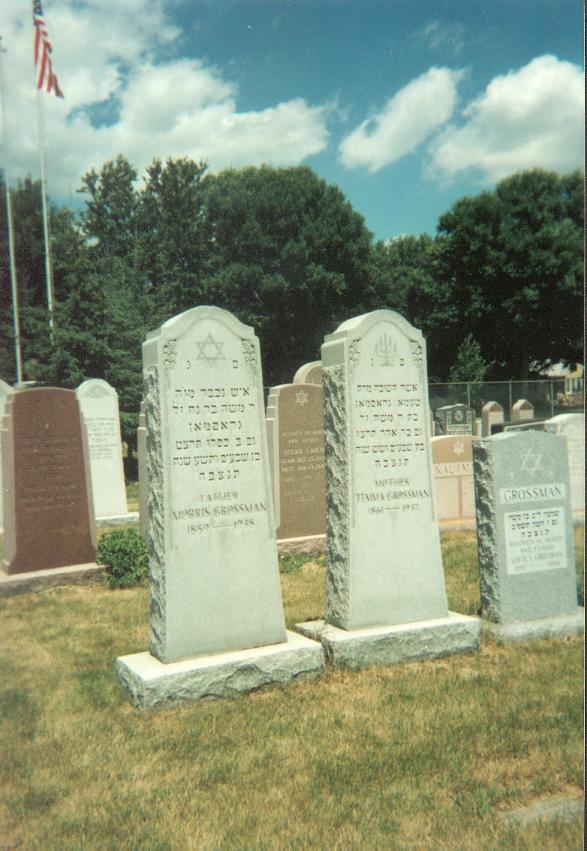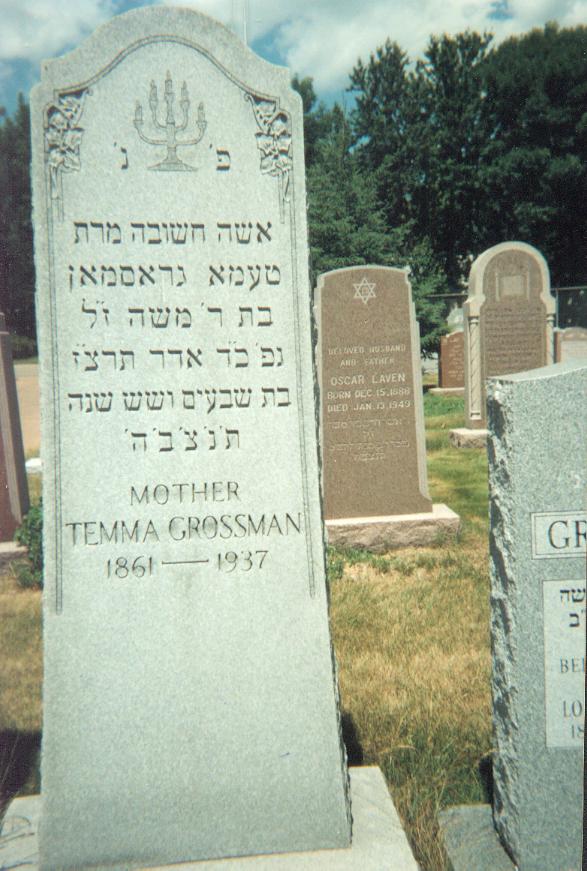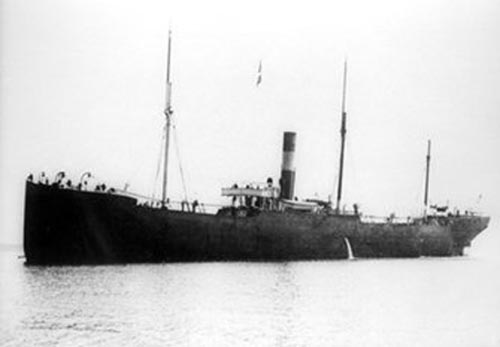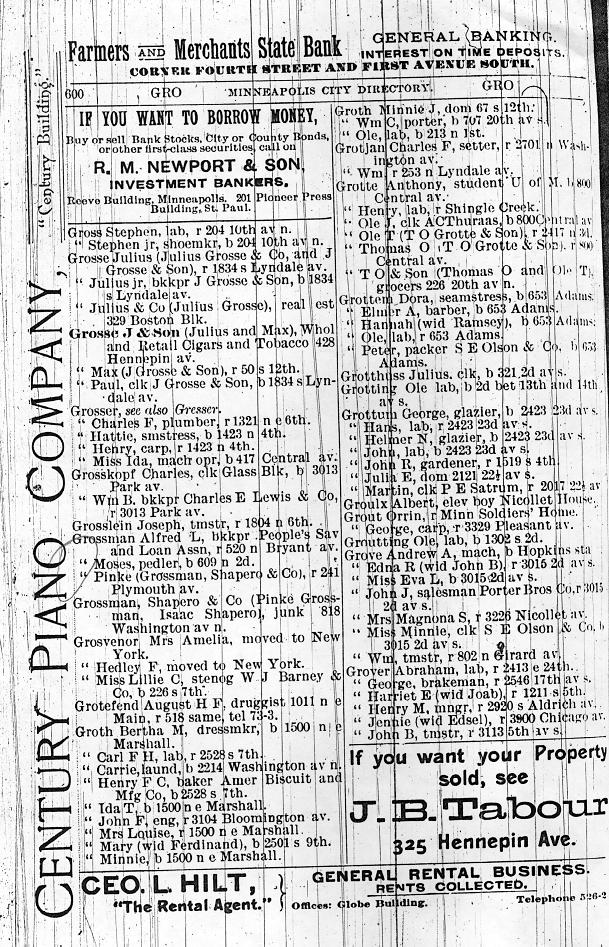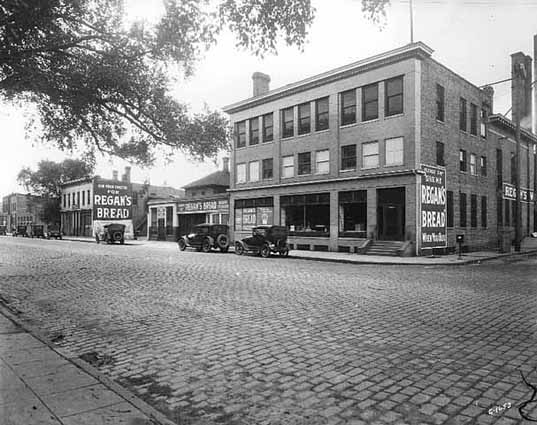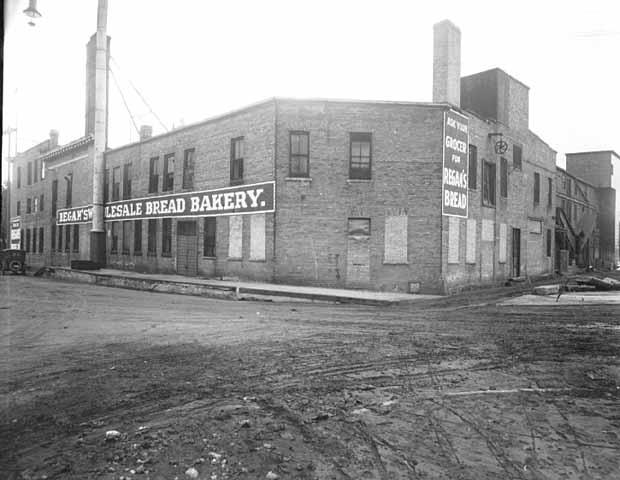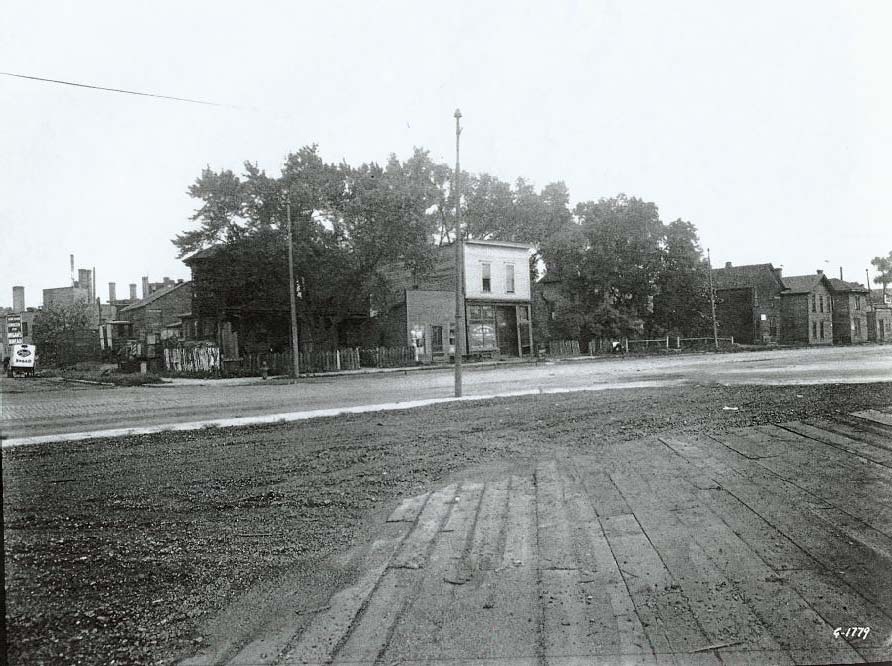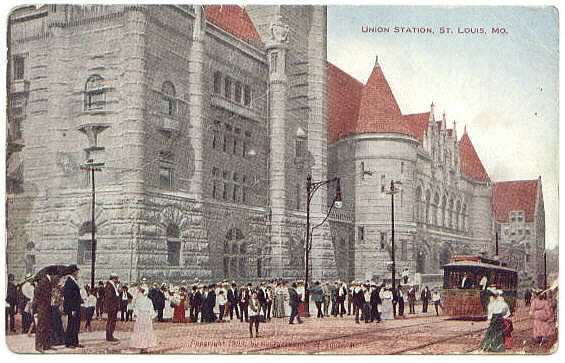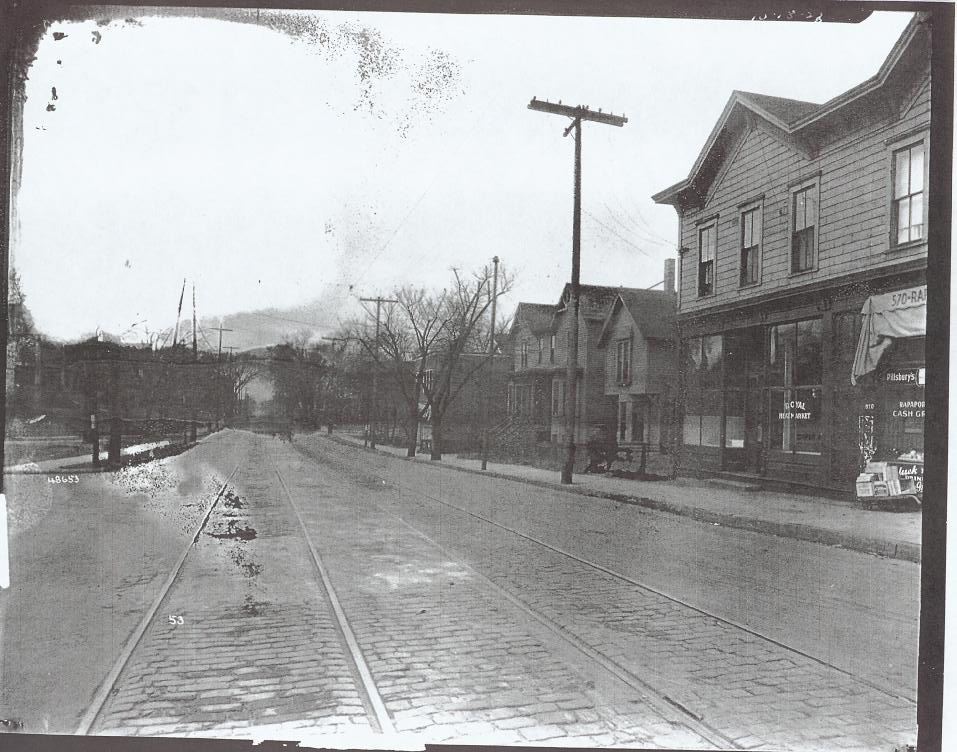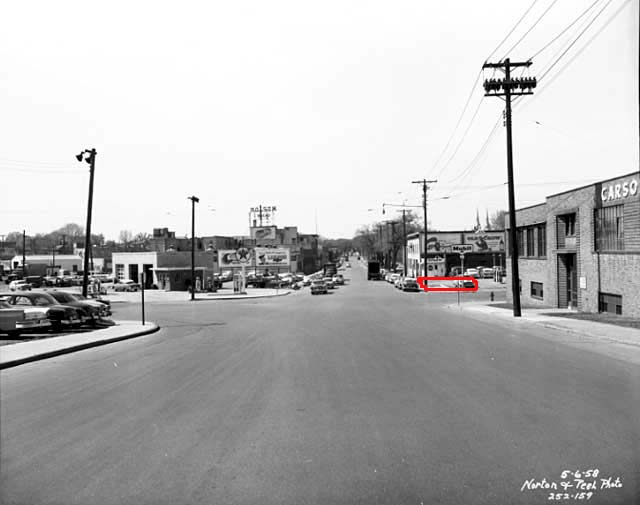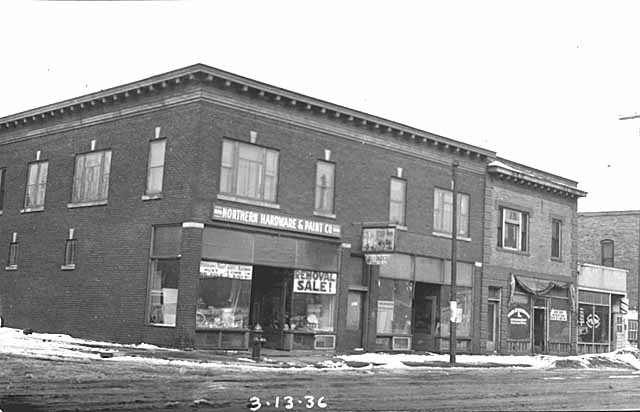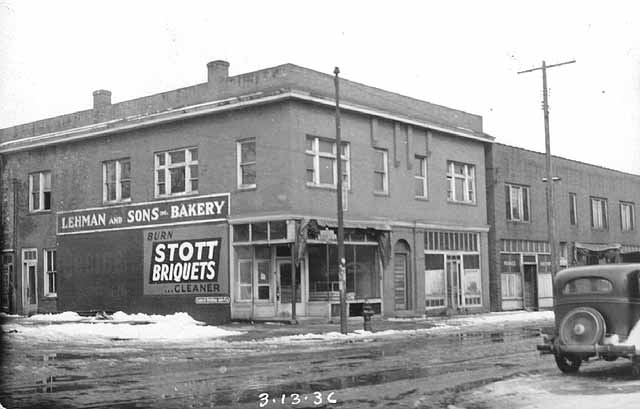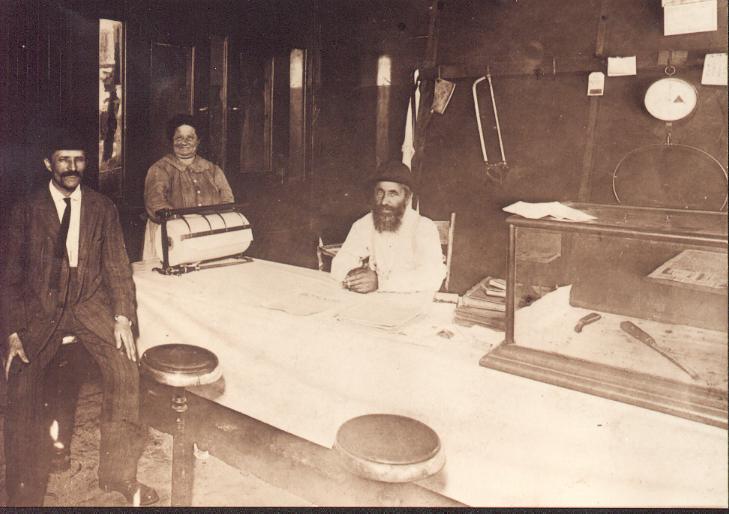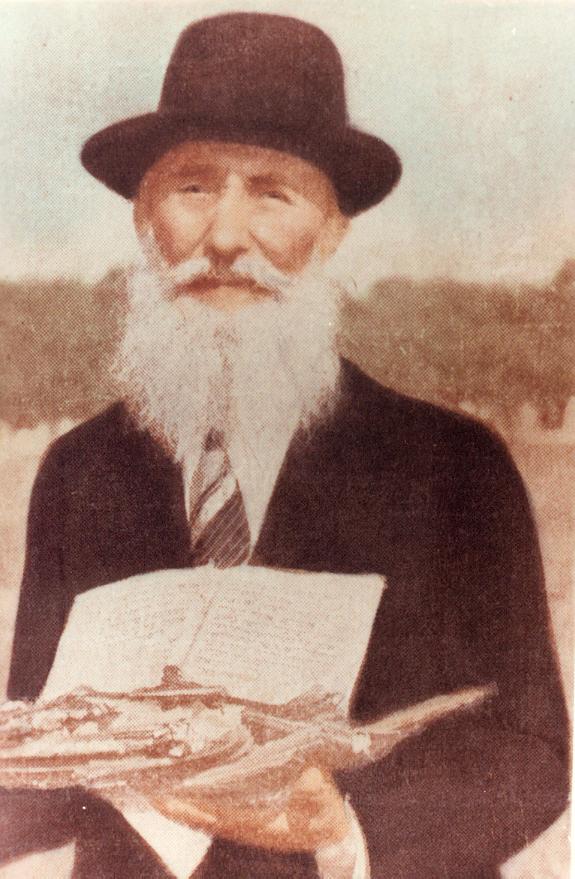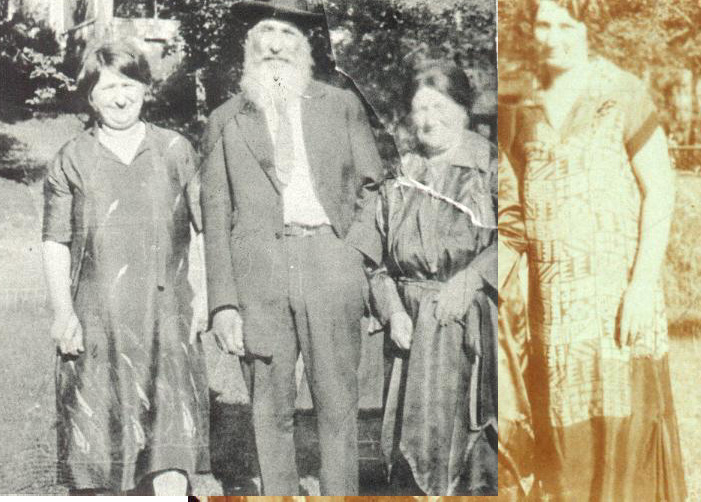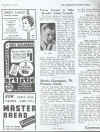|
|||||
|
Not far from the main entrance to the same cemetery stand the matching austere gray tombstones of Moishe and Temma Grossman, my great-great-grandparents.
Tombstones of Moishe and Temma Grossman
Moishe Grossman’s tombstone
Temma Grossman’s tombstone As I explained above, Moishe (or “Morris”) was born in 1859 in Sudilkov and emigrated to America in 1890. His wife Temma was born in 1861 in the same town or a nearby shtetl and emigrated with her two daughters in mid 1892, two years after her husband. These dates are confirmed by information I gathered from the Twelfth Census of the United States (1900), and were further corroborated by Marion Shapiro, who recalled that her grandfather Moishe arrived in the New World quite some time before his wife and daughters. I have learned that many of those who fled Sudilkov at the end of the nineteenth century departed for the United States from the German port of Hamburg. Fortunately, many of the passenger lists of travelers departing for the New World from that port have been made available on-line. In fact, I located a “Mordche Grosmann”, passenger number 96868, born “1859/1860”, who was 30 years old when he left Hamburg for New York—accompanied by an unspecified number of family members—on the German steamship Amalfi on July 18, 1890, passage number A1890.0220. The voyage was direct, with no intermediate stops. The shipping company was Rob. M. Sloman & Co., the shipping agent was Hamburg-Amerikanische Packetfahrt-Actien-Gesellschaft, and the captain was a man named Kraeft. On the Internet I found the following information about the ship: The “Amalfi” was built by M.Pearse & Co, Stockton in 1881 for the Sloman Line of Hamburg. She was a 2,345 gross ton ship, length 300.5ft x beam 36.1ft, one funnel, three masts, iron construction, single screw and a speed of 11 knots. There was passenger accommodation for 600-3rd class. Launched on 7/5/1881, she sailed on the Hamburg - Australia service until 1886 when she came under the control of the newly formed Union Line. She commenced her first Hamburg - New York voyage on 19/5/1886 and started her last voyage on this service on 27/7/1898. In 1911 she was sold to Swedish owners and renamed “Ada”. On 9/6/1917 she was torpedoed and sunk by the German submarine U.61, while 25 miles east of Fair Isle. [North Atlantic Seaway by N.R.P. Bonsor, vol.3, p.1166] - [Posted to The ShipsList by Ted Finch - 14 May 1998]
German steamship Amalfi, built 1881, torpedoed 1917 Although I cannot be absolutely certain that “Mordche” is the same “Moishe” under consideration, in all probability it was indeed him, especially since his emigration date and birthdate correspond perfectly. The only anomaly is that his place of residence in “Russland” is listed as “Dublin”, a weird contradiction. Interestingly, his occupation is listed as “Schneider” (tailor). Although Moishe was a mature 30 years old when he immigrated to Minneapolis, I was able to learn very little about his former life in Volhynia Gubernia. My grandfather Bud Grossman had not been told much about his grandparents by his parents Max and Ida, not even the name of the town in Europe where they came from. When I interviewed him on July 21, 1996 the first thing I asked him was what he knew about the origins of the Grossman family. He responded, “Not a lot. Because my Dad and mother were not very interested in talking about where [Moishe and Temma] came from, and it seemed that they wanted to really become Americans, act like Americans, and there wasn’t the interest in antecedents that you see today. But I knew my grandfather, and I think I was 16 or 17 when he died. He never once, ever, mentioned a word to me about his life, where he came from, or where my grandmother came from, nor did any of his children, including my father, ever talk about it. But I do on occasion remember certain bits of information. For example, my father [told me that his father had had land]… I asked how much, because I realized that Jews in Russia lived in ghettos, and he said that it would take more than a day on a horse to ride around all of the land. Now this was kind of strange coming from my Dad, because land [and] farming—or farms—were nothing he was associated with, nor were horses. And so that kind of surprised me. But from that I gathered that there was some affluence there... There was no encouragement to discuss [these matters] at all… And my impressions of my grandparents always were that they brought nothing with them to America and that they survived by having a butcher shop. My father sometimes described it as the first kosher butcher shop in Minneapolis. I’m not sure that that was so, but there was a sense of pride about it, and I remember it as a child.” I interviewed Harold Irving Grossman (born 29 Apr 1926 in Minneapolis), Bud’s younger brother, on August 8, 1996. Harold recalled that “there was a picture in [Moishe’s] house of a man—a fairly good-sized man—with a big black beard... And this man was purported to be his [father], and he owned a brewery, according to Max.” The man Harold saw in the photograph must have been Noah Grossman, my great-great-great grandfather, born about 1830/40. It is interesting to speculate that the Grossmans and Biermans were in business together as brewers in Kornitsa or Sudilkov. Unfortunately, there is no way to prove this, therefore it must be left to our imaginations. According to Daniel Bierman, Chaya Fraida Grossman’s grandson, Noah was a highly revered man and that is why so many Grossmans and Biermans are named after him. Daniel knows for a fact that his brother Noah and uncle Noah (Norman) were both named after him. Noah or “Norman” is in fact the most common male name among the Grossmans and their descendants, many of whom are Bermans. There are or were nine Normans and four Noahs among first and middle names in the extended family, all of whom were named after the same man! Ten of the thirteen are living today. Norman’s wife Miriam, also born about 1830/40, also seems to have been admired by her descendants. I counted three Marions who were apparently named after her, one of whom is alive and well today. To review, by 1891 Moishe lived at 609 North 2nd Street with his brother-in-law Jacob Dov Berman, his sister Chaya Fraida, his two infant nephews Jessie and Sophie, Aria Berman, Motel Berman, and possibly Motel’s family. In the Minneapolis city directory of that year he is listed as a “pedler”.
Moses Grossman listed in 1891 Minneapolis city directory By mid 1892 his wife Temma arrived with their daughters Grace and Hattie, who were 11 and 7 years old respectively. Around 1893 or 1894, after Chaya Fraida gave birth to their third and fourth children, Jacob Dov and his family moved out to Washington Avenue North in order to start their bathing business. No later than 1895 Rebecka Grossman, Mechel Berman, and possibly the latter’s wife Ethel and children Sophie and Jennie crammed into the flat where Moishe and his family were still living. By then Temma had given birth to two more children, Lou and Max. We can imagine that living conditions in the flat were difficult at best. However, Moishe and his family remained there until at least 1896, and possibly until as late as 1898. The entire time he worked as a peddler, scraping together just enough money to feed his family and contribute to the rent. He probably spent many of his days wandering around downtown with a pushcart selling what he could. His address was 609 North 2nd Street in the Minneapolis directories of 1891, 1893, 1895 and 1896. From the time Jacob Dov got “the Bud” up and running in 1894/95, Moishe probably worked with him part time, if not full time, but I cannot be certain. In 1899, Moishe, Temma and their children Grace, Hattie, Lou and Max were once again living with Jacob Dov and his family, this time at 328 7th Avenue North, right next to the baths. By then Jacob Dov and Chaya Fraida had six children, ranging in age from one to eleven years old. By my count there were fourteen Grossmans and Bermans living together in the same home, including nine children! One can only wonder how anybody got any sleep! According to the 1900 to 1905 Minneapolis directories Moishe (“Morris”) Grossman lived at 618 6th Street North, between 6th and 7th Avenue North, just around the corner from the famous Regan Bros. Bakery.
Regan Bros. Bakery, facade on 7th Avenue North, circa 1924
Regan Bros. Bakery on 7th Avenue North and North 6th Street
On June 14, 1900 an enumerator named Nathan Eisenstadt presented himself at the doorstep of the Grossman household and asked to speak with the head of the family. Eisenstadt’s job was to survey the 3rd ward of the city of Minneapolis for the 1900 Federal Census, the most detailed in the history of the United States.
Eisenstadt described Moishe as a white male, born in “Russia” in 1860 (although on his tombstone the year is 1859). From the form we also learn that Moishe had been married for 22 years, hence he wed in 1878 at the age of 19. He immigrated to the United States in 1890 and was subsequently naturalized, probably at the Hennepin County Courthouse. He could read, write and speak English. His occupation was “Peddler-Junk”. He rented his home at 618 North 6th Street. Temma is characterized as a white female, born in “Russia” in 1860 (1861 on her tombstone). From this I deduced that she married at 16 or 17 years old! According to the same form, Temma bore eight children, but apparently only four of them survived. These were Grace (“Nessie” on the form), December 1, 1881-July 19, 1975; Harriet (“Hattie” on the form), March, 1885-March 4, 1967; Louis Sydney, June 30, 1893-November 3, 1981; and Max, March 10, 1895-December 31, 1981. When Grace was born in 1881 Temma was only 19 or 20 years old. Therefore, it is highly unlikely that she lost all four babies between the time of her marriage in 1878 and early March, 1881, when she conceived Grace. It is more probable that she lost at least one (if not all) between 1885 and 1890, in the five years between the birth of Hattie and the emigration of her husband. Of course, it is feasible that tragedy struck when she tried to give birth to twins, triplets, or quadruplets. It is even possible that she lost a child or two after her arrival in the United States. Nevertheless, her four children who did survive lived long and full lives. Eisenstadt reported that Temma, Grace and Hattie came to the United States in 1893, but I know they could not have come after mid 1892, unless Lou had been the son of another man! Temma is listed as unable to read, write or speak English. Grace, on the other hand, who was 18 at the time, could read, write and speak English. She was employed as a seamstress. During the preceding year she worked for Robitshek, Frank & Heller. Hattie and Lou, 15 and 7 years old respectively, were attending school. Hattie did not get her first job until 1905, when she worked as a clerk for an unspecified vendor. Lou and Max were the only members of the family born in the United States. On further examination of the census form, labeled Supervisor’s District No. 5, Enumeration District No. 30, Sheet No. 25, it is interesting to note that in the area of North 6th Street and 6th Avenue North there were many junk peddlers like Moishe. In fact, of the six family heads on the page, four were junk peddlers, one a wood dealer, and one a grocer. Two of the six families had Russian boarders who were also junk peddlers. Five of the six were born in “Russia”, which generally meant “anywhere in the Russian Empire”, while the sixth was born in Romania. The six heads were between 19 and 31 years old when they immigrated, thus Moishe was the oldest to do so. They arrived between 1886 and 1892. All six rented their homes and they were all Jews. Five of the six families had a total of 17 children, 12 of which were born in Minnesota between 1889 and 1899. Each of these five families had at least one child in school. Next door to the Grossman home, at no. 620, lived the Beiliches family (Isaac, Sarah and son Abraham). One house further down, number 622, was home to the Kotlers (Nathan, Esther and their six children). Abraham Beiliches (born 1892) and Alex (born 1891) and Mitchel Kotler (born 1895) probably played with Max and Lou while they were neighbors. I found an interesting photograph made in circa 1920 of the intersection of 6th Avenue North and 6th Street North, looking northeast. The building in the foreground is the New Kentucky Cafe at 524 6th Avenue North. Moishe and his family lived on the right side of the street which in the photo veers off to the left, one block down.
6th Avenue North and 6th Street North looking northeast In the Minneapolis directories of 1907, 1908 and 1909, Moishe and his children are totally absent. The reason can be found in a letter that Rosalee Borus (9 Aug 1913-), Hattie’s daughter, wrote to Joy Marcus a few years back. In the letter she states that Hattie was 18 when she met Samuel Bierman, her future husband, in Minneapolis. Rosalee claims that sometime after Sam and Hattie met, Moishe and Temma moved to Saint Louis, Missouri “for a few years”, where Louis and Max went to “high school”. Taking into account that one applied six to twelve months in advance in order to be included in the Minneapolis directory, Moishe and Temma must have lived in Saint Louis between 1906/07 and 1909. I found a 1909 postcard of Union Station, where they must have arrived.
St. Louis, Union Station, 1909 postcard Louis would have completed his first two years of high school there while Max finished junior high. Since Sam and Hattie married on June 26, 1906, it seems logical that immediately afterwards Moishe and Temma went to live with either them or a Bierman in-law in Saint Louis. Moishe probably knew many of the St. Louis Biermans from his Sudilkov days, since both his uncle Jacob and his sister Chaya Fraida had married into that family before he emigrated. Arthur Bierman, Hattie’s youngest child (6 Sep 1918-), corroborated his sister’s account and added that Grace and her husband were also in Saint Louis. Apparently Grace did not wish to live without her three siblings and therefore convinced her husband Harry Stillman to leave his hometown, at least temporarily. Thus Moishe, Temma and all four of their children were in Saint Louis together for about three years, possibly in the same house. Arthur claims that they moved there before Hattie got married. If this is true, it could not have been long before then, because Moishe is listed in the 1905 Minneapolis directory. Harold Grossman, Lou’s son, also remembers that Moishe and his family were in St. Louis in those years. He knows for a fact that Max Grossman had his bar mitzvah there. According to Arthur, Moishe eventually returned to Minneapolis because he had been the “tiller of the shul” there. Apparently things did not go too well for Moishe in Saint Louis, where he probably worked in some capacity for his son-in-law Sam. Consequently, he and his family returned to Minneapolis, perhaps in late 1909. Moishe resurfaces there in the 1910 city directory under the following listing: “Morris meats 602 N 5th r 604½ same”. From this we learn that he finally abandoned his 20-year career as a peddler and started his own business, a kosher butcher shop, at the age of 51. I suppose he got some financial assistance from one of his two married daughters, Grace or Hattie, or perhaps from his brother-in-law Jacob Dov Berman, who lived and worked just around the corner at 410-420 6th Avenue North. I found a 1923 photograph at the Minnesota Historical Society depicting the intersection of 6th Avenue North and 5th Street, across the street and a few doors down from where butcher shop stood. Although “Morris Meats” is not visible, the image gives a general idea of what the area once looked like.
6th Avenue North at 5th Street, photo 1923 In a 1958 photograph I have identified the site of the butcher shop, now occupied by a parking lot.
Like Jacob Dov, Moishe and his family lived right next door to where they worked. 602-604 North 5th Street can be identified on the 1912 Sanborn map [See map above, item#1]. The twin buildings, only two stories high, shared an east-west wall and were connected in the back by a closet-like space, which at ground level must have been for storing meat and live chickens. The butcher shop occupied number 602 while the family lived in number 604½. By 1910 only Lou and Max lived at home, and therefore must have shared either the upstairs or downstairs room while their parents lived in the other one. The entire apartment, both ground and upper levels, had a surface area of approximately 1750 square feet, 875 square feet for the business and 875 square feet for the residence. It was a very restricted space with absolutely no frills. At the time, Louis, who was 17 years old, was working as a stockpiler for L. S. Donaldson Company, in the center of downtown. By 1915, a grocer named Nathan J. Berman lived next door on the corner at no. 600. Nathan worked at 1127 Emerson Avenue North with Jacob, Joseph (brother?) and Louis Berman. I want Nathan to be Edward J. Berman, the son of Motel (Max) Berman, but I have failed to identify Jacob and Louis and therefore cannot be certain. By 1915 the Grossmans had moved their residence and kosher butcher shop to 1021 6th Avenue North, on the southwest corner of Dupont Avenue North, where they were to remain until 1927.
Moishe Grossman's second Butcher Shop Located across the street from Mayer Camiel’s Barber Shop (#1004), North Hardware & Paint Co. (#1010) and Lehman and Sons Bakery (#1020), this is the site that my grandfather Bud and his siblings and cousins remember from their childhood.
1004 6th Avenue North, Mayer Camiel’s Barber Shop, photo 1936
1010 6th Avenue North, Northern Hardware & Paint Co, 1936
1022 6th Avenue North, Lehman and Sons Bakery, photo 1936 Evidently, Moishe and Temma had decided to move into the newer neighborhood west of the heart of downtown, where many of the Jews had already relocated. As I explained above, around the time of World War I, 6th Avenue North was the main drag of North Minneapolis. Moishe’s sister Chaya Fraida had moved there after Jacob Dov passed away in 1912, to no. 810-812. The Sumner Branch of the Public Library, a neighborhood landmark, was across the street and about 100 yards to the west. On the 1912 Sanborn map there is only an 875-square foot empty lot where the new residence and butcher shop were to be built. The Grossmans must have lived directly above their business, an arrangement which had been typical in Europe since ancient Roman times. In the Minnesota Historical Society archives I located an interesting document drawn up by a tax assessor in the year 1920. Esther Kaplan, the owner of an L-shaped lot which included 1021 6th Avenue North, was assessed a property tax that year of $243.71, which was 7.55% of the value of her $3,230 property. The Grossman butcher shop and residence occupied just about a quarter of Kaplan’s property, and thus was worth approximately $800. Five to seven years earlier, when Moishe actually moved in, I estimate that the structure was worth approximately $500 to $600. In 1920, the total tax on Kaplan’s property consisted of a general duty of $197.35, a street sprinkling fee of $3.35, a “park” tax of $1.04, a curb and gutter cleaning fee of $12.43, the interest on a “Revolving Fund” of $.62, and “street acquisition” taxes and interest totaling $29.54. Kaplan paid her tax in two semesterly payments of $121.86 on May 19 and $121.85 on October 31. Norman Grossman, Lou’s son, vividly remembers the butcher shop at 1021 6th Avenue North. In my interview with him on July 21, 1996 he told me: “Well I have a photograph that I just discovered that my mother had saved... after she passed away. I looked through her belongings and there it was. And it shows them [Moishe and Temma] in their butcher shop on 6th Avenue North, pretty young looking. And... apparently... a customer or a salesman or something. [Moishe] was sitting behind the counter. [Temma] was standing behind him, and behind her was a big giant... walk-in ice box or refrigerator where they... actually used ice to protect the meat and he, as I remember him, he perennially and nearly always had a long-stemmed cigarette holder with a very long Russian-type cigarette in it, and he used to poke that way back into his mouth and suck on it all day long. And that’s about as much as I can tell you because I was there maybe three times in my whole life, and the picture showing the store itself is very familiar to me from that standpoint.” Norman also remembers the sawdust that was always on the floor. The photograph described by Norman is impressive, and represents the earliest known image of Moishe and Temma. The “customer” at the counter is Harry Stillman, the husband of their daughter Grace.
Harold Grossman, Lou’s other son, told me the following: “As I recall it, [Moishe] cut the meat and [Temma] did the selling and the wrapping, and she could add a list of numbers faster than you could put it on a computer. She had a computer head. She’d run right down those columns and bing’em!… You assumed she did it properly, correctly, or accurately, but she’d have those numbers. And, strangely enough, both her sons, and the one daughter—I know for sure—had the same kind of mathematical ability and certainly [Grace] did, and so did Max and so did Lou. I remember we used to go there one night a year, and sit in the back of the store and we’d have a meal back there. There was no electricity. We ate by... gas light and for us little kids it was a nightmare because there was hardly any conversation. He was a very austere guy. There was no small talk in him it all… He and grandfather Berman [Mechel] were great friends... and any number of Saturdays when I was a little kid I’d trot with grandfather Berman to the small, small little synagogue, and I’d stand there ‘til I thought I was gonna drop while they were praying... it was a little one-room [synagogue] down near 6th Avenue someplace... probably was Oak Lake, and those two older men would stand side by side and would doven and shake back and forth... It seemed to me forever... I was a little kid. But also I think its interesting that grandfather Berman would hitch his horse to his wagon and he would go over to grandfather Grossman and deliver meat for him periodically, and a couple of times I know I rode the wagon with him. I don’t remember too much... I remember they had to do it fast. There was no refrigeration. This was summertime.” My grandfather Bud Grossman remembers a similar story that his father Max told him a number of times: “Now [Max] liked to tell a story... how when the butcher shop existed, that they had a man to deliver the meat. And when the man didn’t show up, his father (Moishe) would call, and Lou and [Max] used to have to come down and deliver the meat in the morning, before they went to work. Now this was his story... He told the story more than once.” Marion Cohen (17 Aug 1916-), Max Grossman’s daughter, had this to say: “Grandpa [Moishe] Grossman was very religious, VERY religious... He was very austere, not very warm... He had a long white beard, and he was very stern...very… It was really hard to see grandpa’s features because he had the long white beard. But you had the feeling he was a handsome man.
Moishe Grossman, circa 1930 He was intimidating in appearance because he was tall for his generation… My grandmother [Temma] was just the opposite. She was a businessman. And he was a scholar, religious. It seemed to me that he was always praying. We used to see him more frequently than any of the other kids.” When I asked Marion about the butcher shop she told me “It was tiny. The two of them ran the butcher shop and lived behind it.” The meat was kosher and all the clients were Jews. “I have a lot of memories of the butcher shop, but primarily of my grandmother working... flicking chickens. They didn’t have a cash register then. [Business] was done with cash but they didn’t have a register.” They worked hard, but never during shabbas. “They had a shabbas goy. They never turned the light on, never built the fire. They had somebody come in and do it.” They were strictly observant, “he especially. He would not allow his meat to be delivered by a gentile.” Marion Shapiro, Grace’s daughter, agreed: “[Moishe and Temma] were very strict... Not only that but... they had to get somebody from the outside to light a fire. Floyd B. Olson lit their fire.” She added, “He was our governor...a shabbas goy!” Marion remembers Moishe as cold and frightening: “I think he [Moishe] worked during the week [but not on the Sabbath]. And my mother [Grace] used to like to bounce a ball, play ball. If she was caught doing that on the Sabbath... she’d get spanked somehow. He was very strict, and she could not go out with a man that didn’t observe the Sabbath.” Norman, Lou’s son, recalls that Moishe was known in the neighborhood for his hot temper. Francis Yedidia, Hattie’s daughter, remembers going into the butcher shop only once. She was very proud of it. When she went back to Saint Louis she told everyone that her grandfather had a butcher shop. She remembers him as a religious man who constantly prayed and studied. Fran’s younger brother Arthur met Moishe two times in his life—in 1926, when he and Temma came to visit them at Lake Minnetonka where they had been spending part of the summer; and again in 1928, when Temma was very ill and Hattie took her children with her to visit them. However, Arthur said he did not get to know him. He recalled that Temma ran the butcher shop because Moishe was always at the shul. He was a very learned scholar but was not very interested in business. Fran commented that during her summers on Minnetonka her Grossman grandparents were rarely if ever present. Harold Grossman, Max’s younger son, remembers Moishe as “a tall man. He was a chain smoker. He was a very religious man. And he was a nice man. He apparently never was very successful in business. And Lou and Max used to help him out, and again this was hearsay, and as I remember it—and it may be way off—they claimed to have delivered the meat... He had a butcher shop... but they used to deliver the meat... before they drove cars... in wagons… If I remember, [Lou and Max] would make up the orders, but that was an ill-fated financial venture...” Harold, born April 29, 1926, was an infant when the butcher shop was sold and therefore has no memory of it. My grandfather Bud Grossman seems to have been close with his grandfather Moishe, as Harold and Marion certainly were. This was mainly because Max, Moishe’s son, spent a lot of time with him and brought his children to visit regularly. In my interview with Bud he told me that Moishe “was a tall man, and he was a healthy-looking man, and he had a great big white beard, and he always wore the traditional Jewish hat, which [had] a big wide brim [with] a big head, and it looked very natural and he wore it all the time. Generally, he wore it in his house [and] he didn’t wear a skullcap. If you recall pictures of the orthodox Hassidic people who live in Israel... that was the type of hat I’m talking about. And a big beard. But he was an affectionate man. I remember when I’d come he’d put his arms around me and he would hug me and he would kiss me and I used to visit him frequently. My Dad used to take me... He always smelled of tobacco. He rolled his own cigarettes, and they were very strong, and he smoked them ‘til he died. “My grandfather was very [religious]... He went to the synagogue every day. Not since I knew him did he ever work. And the story in the family was that my grandmother [Temma] ran the butcher shop. And he just went to the synagogue everyday.” When I asked Grandpa whether Moishe spoke English to him he responded, “I don’t recall that either. Yiddish was spoken in the home and that was it, and he was a kind of a... introverted person, but a very positive person. [He] projected a strong personality, and I think my father and my uncle were afraid of him… and they respected him very much. That was something that came through all the time. And his wishes were what happened. It was kind of a patriarchal situation.” Moishe came from a culture in which the wishes of parents were never called into question, one of the basic tenets of Judaism. Rosalee Borus concurred with my grandfather Bud. She said that Moishe was always busy at his synagogue while Temma worked in the butcher shop. Irene (Silesky) Stillman (born 3 Mar 1908) recalled that Moishe was very religious: “No Work. All study.” She remembered that he and Temma were present at her wedding to Arthur Zelig Stillman, Grace’s son, on January 28, 1930. Arthur Bierman claimed that Moishe was uninterested in business and was strictly a scholar. Like Bud, Harold and Norman (Lou’s sons) remember that Moishe and Temma spoke little English, but understood it well enough. Marion Shapiro recalled that Temma spoke only a few words of English. In late 1926 or the first half of 1927 Moishe and Temma, 68 and 66 years old respectively, finally sold the butcher shop and went into retirement. My grandfather Bud told the story as he remembered it: As Max and Lou got older and went into business they were unable to help deliver the meat, “so they tried to get their father [Moishe]... to sell the butcher shop. Well [Moishe] didn’t want to sell the butcher shop, and every time [they tried to talk about it he’d say] ‘Nobody will pay what this is worth!’ So [Lou and Max] went out... and found a man who wanted to buy the butcher shop and they... set the price with the guy and [told him], ‘Go buy it. Pay whatever you have to and we’ll pay you the difference!’ And that’s how they sold the butcher shop… and that’s when they moved into this apartment.” The apartment to which Grandpa referred was located at 1236 Logan Avenue North. Actually, by 1928 Moishe and Temma had moved to 820 Logan Avenue North, but by the following year were living at number 1236. The couple remained there from 1929 until about 1930/33. By 1934 they were living at 1241 Logan Avenue North, just across the street. There they lived out the rest of their days. I located two photographs of Moishe and Temma that must have been taken in the period around 1930. Amazingly, the two photographs were taken at the same moment and include different people from the same group. Thus, I digitally merged the two images into a single photograph.
Curiously, there were several other Grossmans, apparently unrelated to Moishe, who lived or worked on the same street. A grocer name Chas Grossman, listed in the Minneapolis directories starting in 1908, lived at 807 Logan in 1929. Rose Grossman, a US customs officer, Samuel Grossman, a peddler, and Shirley Grossman, a stenographer for the Fireside Index Library (1929) and then for United Artists Corporation (1930) all lived at 801 Logan Avenue North. A clerk named Eugene Grossman lived at 1123 Logan in 1929. In 1930, at 1502 Logan Avenue North, Frieda M. Grossman was a bookkeeper for Benjamin Grossman. In 1935, in addition to the aforementioned Samuel, a number of other Grossmans lived at number 801, including Betty, a clerk at Sears Robuck & Company, Dorothy, a stenographer at Maxim’s Chain Beauty Parlor, and Jessie, also a stenographer. Meanwhile, Rose, who had moved to 1016 Logan Avenue North, was a “helper” at Prosperity Cleaners & Dyers. Although I have been unable to identify as relatives these Grossmans living conspicuously on the same street as my great-great grandparents, it must not be not ruled out that they are somehow related. Harold Grossman (Max’s son) told me that he used to visit Moishe and Temma at least one a week at their place on Logan: “I’d stop and visit them and then after visiting them I would stop and see Harry Stillman and visit with him. But I used to go over once a week, from Hebrew school. My Hebrew school was on 7th and Logan.” Harold also recalled having gone to shul with Moishe once or twice. The synagogue “was on the corner of Oliver and 10th, Mikro Kodesh... And he lived on Logan and 12th.” Harold remembers his bar mitzvah there in 1939, when he had to recite a speech in both Hebrew and Yiddish. It began, “Lieber Mutter, Bruder und Freunde...” He explained, “You had to give a speech, and it was really funny because nobody knew what they were saying unless they came from a family that didn’t speak English.” Harold, like John Marcus, attended the Hebrew School on Logan, where George Scherling prepared him for his bar mitzvah. Harold recalls that his father always took him and his siblings to the Passover Seder at their grandparents’ on Logan. What he remembers most was that “They were LONG seders... [They] started out about 7 and finished about 11, 11:30.” My grandfather Bud Grossman has especially strong memories of Passover at his grandparents’ home: “The furnishings in the apartment were very plain, and my most vivid recollections were the visits and the holidays, particularly the Passover, which was a marathon… And you couldn’t say anything. You couldn’t do anything. And the four questions were always traumatic, you know [laughing].” Max Grossman and his children were always there for Passover. Marion Cohen, like her brothers, recalls that Seders were excruciatingly long: “Well you sat there ‘til after twelve o’clock. He [Moishe] didn’t cut any corners. It was torture. [laughing]” She told me that there were no gatherings of Moishe with his children. His children lived separate lives and started there own families. According to her, Moishe had come from a world in which the priority was survival, and therefore the unity of the family was less important in his mind. Marion, like her brother Harold, cannot remember seeing Moishe’s four kids together, but she imagines that they reunited more often when they were younger. I asked my grandfather how often he saw Moishe and Temma in the 17 years he knew them between 1921 and 1938. He answered, “At times frequently. At others less often, maybe once a month. Almost always my Dad would be the person to take us over there.” Since Bud was very young when the butcher shop was sold, he mostly remembers the period after they retired. Moishe “would just get up in the morning and go to the synagogue every day, and that was his life… He was one of the founders [of Mikro Kodesh Synagogue], and my Dad [Max] was active in it. [Max] was the president of the synagogue, and I remember hearing a lot about the politics, a lot... There were cliques in the synagogue. And, you know, the world was a small place. And my grandfather and another man… were always on the opposite sides of the fence, on everything, but they were great friends.” The man in question was named Shmuel (Samuel) Nissenson and he was born in Krivoy Rog, Ukraine. His daughter Vera Lyons (28 July 1913-) is the mother of Lisa Lyons (13 Dec 1950-), my stepmother. Bud knew of him and that he was exactly the same type as Moishe and were often to be seen together. I was able to learn much less about Temma than about her husband Moishe, mainly because she did not speak English and thus communicated very little about herself to her grandchildren.
Temma Grossman, circa 1925 According to Minneapolis Hadras, the Jewish burial society associated with the Grossmans, Temma’s maiden name was Snyder (sp?). No one in the family has been able to confirm this for me, but whoever arranged for her burial in 1937 wrote that name on the document which is still on file. My grandfather Bud remembers Temma as “a small woman. She was small. She was plump. She was blue-eyed—I remember that—and always pleasant.” Harold Grossman, Lou’s son, recalls that she was “a very quiet lady, good cook. Very short. Non conversant, of course. As I remember, she looked like Lou. Lou looked like Temma. Sort of grayish blond, short, fairly stocky, as I can remember her… I didn’t speak Yiddish and she didn’t speak English.” Arthur Bierman told me that she was a pleasant, short and stocky woman who took care of the family butcher shop. Rosalee Borus described her as a little, round woman who depended much on her sons Lou and Max. Francis Yedidia remembers her simply as a very sweet and kind person. Marion Shapiro characterized Temma as a businesswoman who fought much with her husband. Morris never recorded his charges, so Temma would often hurry to write down what he did not. Her enthusiasm for business sometimes caused her to neglect cooking and cleaning, which made him angry. She was chubby and short and wore a wig. Harold Grossman, Max’s son, told me the following: “Well, I knew my grandfather and grandmother. My grandmother [Temma] never spoke one word of English, and we couldn’t communicate with her. I’d stop by after Hebrew school, when I was going to Hebrew school at that time, and I’d have nothing to say to her, nor could she say anything to me. But she’d be sitting in a big, overstuffed chair and I’d come up and sort of sit on the arm of it. She’d give me a hug and a squeeze. And that was my total contact...with Temma.” Harold’s sister Marion Cohen recalls that she and her mother Ida Grossman used to go over to Moishe and Temma’s to help keep their home kosher, which was very hard work. Ida used to do that as a favor for her mother-in-law. Temma passed away in 1937 and Moishe passed away on November 24, 1938. Moishe was apparently a healthy man until shortly before he died, when he was diagnosed with throat cancer. Temma, on the other hand, was in poor health during the last years of her life because she suffered from diabetes. Moishe’s obituary appeared in the Minneapolis Tribune on November 26, 1938 and then in the American Jewish World on December 2.
The prominent headline in the latter reads “Morris Grossman, 79, Pioneer, Dead”. I cite the article in full: “Morris Grossman, 79, 1243 Logan Avenue North, a pioneer resident of the Jewish community, passed away Thanksgiving day. Final rites were conducted the following day at Mikro Kodesh synagogue under the direction of Hodroff mortuary. Rabbi S. T. Swirsky officiated. Interment was in the United Hebrew Brotherhood cemetery. “A native of Russia, Mr. Grossman had lived in Minneapolis 50 years. He was among the founders of the Mikro Kodesh synagogue. Survivors are two daughters, Mrs. Harry Stillman of this city and Mrs. S. Bierman of St. Louis; two sons, Louis S. and Max Grossman of Minneapolis; two sisters, Mrs. J. Bierman of Minneapolis and Mrs. E. Grossman of St. Louis; 16 grandchildren and nine great-grandchildren.” I calculated that if Moishe and Temma and all of their direct progeny had been alive in 1996, the couple would have counted 4 children, 17 grandchildren, 45 great-grandchildren, 77 great-great grandchildren (3 of whom were adopted), and 25 great-great-great grandchildren. As of that year, when I conducted my own census by telephone, Moishe and Temma had 165 direct descendants! |
